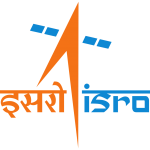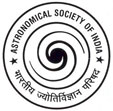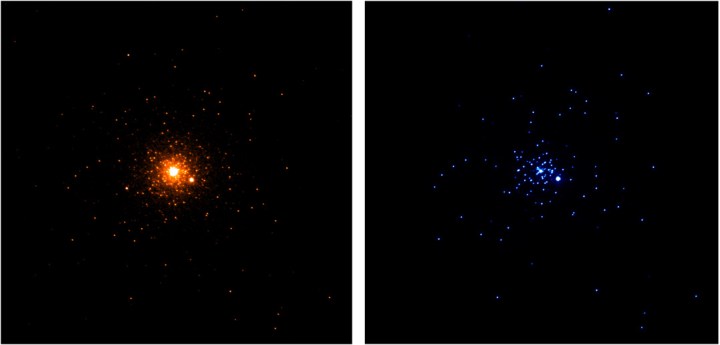November 2017:
The AstroSat Picture of the Month for November 2017 are the Near-UV (left) and Far-UV (right) images of the Globular Cluster NGC 1851, taken by UVIT on board the ASTROSAT. The FUV image shows only the hottest stars in the cluster. All colours are artificial.
(Picture Credits: Annapurni Subramaniam and collaborators )
To download a high resolution image, see link.


“AstroSat Picture of the Month” is an initiative of the Public Outreach and Education Committee of the Astronomical Society of India and the AstroSat Training and Outreach Team.
NGC 1851: One cluster, two populations
NGC 1851 is a Globular Cluster which is almost 40000 light years away from us, in the southern constellation of Columba, near Canis Major. A Globular Cluster is a group of stars tightly bound together by their own gravity. All the stars in these spherical clusters orbit around the centre of our galaxy together. NGC 1851, or Caldwell 73, is one such cluster, visible in a moderate telescope at a magnitude of 7.3, with a size that is a third of the full moon. It was discovered by James Dunlop from Australia in 1826.
The stars in a Globular Cluster are usually born together, and hence share similar properties. However, NGC 1851 is one of the few clusters where two distinct types of stars with different properties seem to co-exist! Many individual stars in this object have been studied before with the HST, but good ultraviolet images were needed to understand this mystery better. This prompted a group of 18 astronomers, including 12 from India, to use the UVIT on board the AstroSat. They imaged this cluster in the Near and Far ultraviolet wavebands far better than earlier attempts with other telescopes.
The superior resolution of AstroSat allowed them, for the first time, to measure the ultraviolet properties of individual stars in the inner crowded region of the cluster. Using this data, they could show that NGC 1851 does indeed have two distinct families of stars within it, which still retain their separate histories. This tells us that NGC 1851 was probably formed when two smaller clusters merged together some time in the past!
The paper describing these results can be downloaded from here.
Click here for the entire APOM archive and here to return to the latest APOM.
More about ASTROSAT
AstroSat, India's first dedicated multi-wavelength space observatory, was launched by ISRO on 28 September, 2015. It has five instruments on board – the Ultra Violet Imaging Telescope, the Soft X-ray Telescope, the Large Area X-ray Proportional Counter, the Cadmium-Zinc-Telluride Imager and the Scanning Sky Monitor.
Get answers to your common queries about ASTROSAT in English, in हिंदी, and in मराठी.

